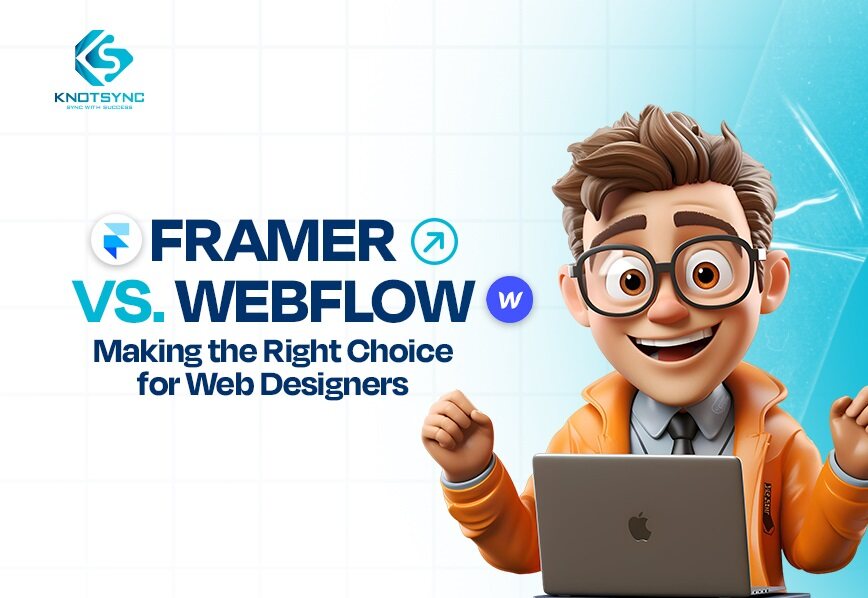If you’re considering designing your website with no code or a low code platform you’re probably wondering, Framer vs Webflow which option to choose? Whether for your newly launched product or professional service, you need a customer-friendly front-end design like these two which can beat all competitors and easily showcase your products and services.
Framer and Webflow are two different website design tools. Each has its own different features. Framer is a no code design tool using which you can design a website from your Figma file without the need of coding.
Whereas Webflow is an advanced logic tool where you need to know and build things using programming languages like HTML and CSS. In the article we will discuss Framer vs Webflow and help you choose the right website design tool between both.
What is Framer?
Framer is a powerful design and prototyping tool that allows web developers and designers to create interactive website design prototypes. It seamlessly integrates design and code, enabling developers to create innovative dynamic UI elements without letting them leave the design environment.
Further, Framer supports React based design tools making it ideal for web developers who want to incorporate animations into their prototypes. With features like components, interactive states, and advanced animations, Framer streamlines the workflow from design to production, ensuring a cohesive and efficient design-to-development process.
What is Webflow?
Webflow is a comprehensive web design and development platform that empowers web developers to build responsive websites visually. It is a CMS for web development, design tool, and website hosting platform, allowing developers for end-to-end web development within a united single interface.
The main advantage it offers is with its visual editor. Using it, developers can write and execute code in HTML, CSS and JavaScript. This helps simplify the process of creating a custom professional website while providing flexibility and scalability needed for website.
What is the Difference Between Framer and Webflow?
The Framer vs Webflow debate has been going on for so long. Framer is not perfect and ideal for everyone. It does not support website design creation from scratch. On the other hand, Webflow is great but requires some knowledge of coding and does not essentially support AI based website design. Let us see some key differences between them to understand which one is better Webflow vs Framer:
| Feature | Webflow | Framer |
| Primary Use Case | Comprehensive website building and CMS integration | Advanced prototyping and interaction design |
| Coding Requirements | No-code/low-code, visual editor for responsive designs | Offers a code editor for full control over prototypes |
| Learning Curve | Beginner-friendly with extensive documentation | Steeper learning curve, more suited for experienced designers |
| E-commerce Capabilities | Robust e-commerce tools, including product management, checkout customization, and payment integration | Limited built-in e-commerce features, requires third-party integrations for payments |
| SEO and Performance | Advanced SEO tools and performance optimization features | Basic SEO features, focuses more on design and prototyping performance |
| Integrations | Seamless integrations with marketing, analytics, and CRM tools | Integrations primarily with design and collaboration tools like Figma and Sketch. |
Now let us go through these differences in detail.
1. Ease of Use
Known for its intuitive drag-and-drop interface, Framer is especially appealing to those familiar with Figma due to its similar features. It offers a vast library of pre-built templates and components, making it accessible for beginners. The CMS also integrates AI to assist in creating layouts, speeding up the design process significantly.
While also featuring a drag-and-drop interface, Webflow has a steeper learning curve. It’s highly beneficial for users with some coding knowledge, as understanding HTML and CSS can enhance the experience.
2.Design and Functionality
Excels in design flexibility and speed, Framer allows quick prototyping and the creation of interactive components. However, it lacks advanced content management and customizable templates, and group functionality features. It is mainly used for building e-commerce website designs due to its limited third part integrations.
Webflow offers robust complex design capabilities alongside integrated development tools. It includes a comprehensive CMS, built-in SEO tools, and is well-suited for creating dynamic, visually stunning websites. The webflow’s built-in hosting features make it ideal for more developers to design websites from core and integrate complex functions easily.
3. Community and Support
Framer hosts a vibrant community with a dedicated forum and Discord channel for support. However, its customer support options are more limited, relying mainly on email and ticket systems.
Webflow has a larger, more established community and extensive resources through Webflow personal community channel. Support includes email assistance and an active user forum, providing ample help for troubleshooting and learning.
4. Pricing
Framer offers a free plan with additional paid tiers (Mini at $5/month, Basic at $15/month, Pro at $25/month). It tends to be slightly cheaper but has limitations like fewer built-in forms and integrations.
Webflow on the other hand, is a little expensive when compared to Framer. The Pricing starts with a free plan Basic at $14/month. CMS available at $23/month and premium business plan available at $39/month. However, despite being more expensive, Webflow’s plans generally offer more features, higher limit per page, and greater share of revenue with businesses.
5. AI and Innovation
Framer incorporates AI features like an AI website builder, text rewrite, and translation tools, enhancing efficiency and accessibility for non-designers.
However, Webflow currently lacks integrated AI features, however it offers robust design and development functionalities.
For beginners or design-centric users, starting with Framer might be beneficial, while those looking for scalability and advanced features might prefer Webflow.
FAQs About Framer and Webflow
Now if you are about to choose between two tools you might have some questions like which one is better, what kind of tools Webflow and Framer are and many more. Let us go through some of them in detail.
Is Framer Better Than Webflow?
Framer has interactive interface and has powered its service with AI powered support during design. Whereas Webflow is yet to integrate AI capabilities in its product making it less attractive than Framer.
What can Webflow do that Framer Can’t?
Webflow has a variety of templates each with its different custom design features. It’s a Canva for designers where user can easily add features such as image section and animations.
What Kind of Tool is Webflow?
Webflow is a website design and hosting platform. It is available only online and supports low code in languages like HTML/CSS. Further it is a CMS for web development tool that also supports multiple third-party integrations.
Conclusion
Website design is the first thing customers see when one visits the website. Thus, it is important that your website is fast, better than others and easy to navigate. Ultimately, whether you choose Framer or Webflow will depend on your business needs. So, if you are creating a website using Framer or Webflow make sure to check perks of each before choosing the website builder.



